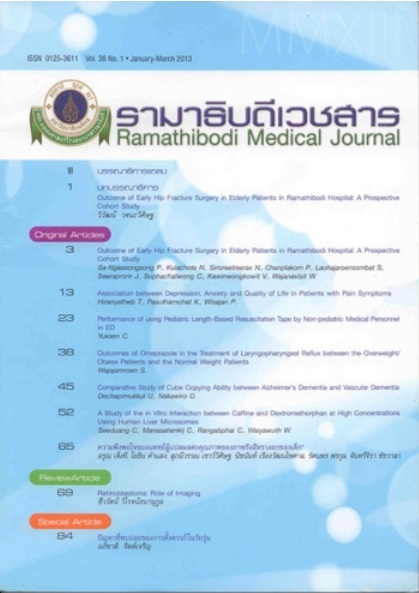Comparative Study of Cube Copying Ability between Alzheimer's Dementia and Vascular Dementia
Keywords:
Alzheimer's dementia, Vascular dementia, Cube copying taskAbstract
Objectives: To study the differences in cube copying ability between dementia patients and normal elderly and between Alzheimer's dementia patients (AD) and vascular dementia patients (VD). We also examined factors that affect cub copying ability.
Methods: 36 ADs and 26 VDs were enrolled from memory clinic of Ramathibodi hospital. All samples were diagnosed by psychiatrists and radiologists in memory conference. Control populations were 40 normal elderly. Cube copying was collected from OPD cards and scoring was made using Maeshima's method. The average scores among each group were compared. Factors that affected cube copying ability were also assessed.
Results: Average cube copying scores in dementia patients (AD + VD, 14.60 5.22) differed significantly from normal elderly (18.75
2.99, P = 0.000). Average cube copying scores in AD comparing with VD showed no difference. Educational factor affected cube copying ability significantly (P = 0.000), as level of education increased, the cube copying score increased. For subjects that graduated from diploma degree and above, average cube copying score in AD was 15.71
4.46 which differed from VD (19.30
1.16, P = 0.004) and normal elderly significantly (19.33
2.16, P = 0.000). Whereas average cube copying score in VD compared with normal elderly showed no difference.
Conclusion: The dementia patients show impairment of cube copying ability when compare with normal elderly. High educated VD can compensate this impairment but not for high educaed AD.
References
Richards SS, Sweet RA. Dementia. In: Sadock BJ, Sadock VA, Ruiz P, editors. Kaplan & Sadock’s comprehensive textbook of psychiatry. 9 ed. Philadelphia: Lippincott Williams & Wilkins; 2009:1167-97.
Graham NL, Emery T, Hodges JR. Distinctive cognitive profiles in Alzheimer's disease and subcortical vascular dementia. J Neurol Neurosurg Psychiatry. 2004;75(1):61-71.
Filley CM, Kelly J, Heaton RK. Neuropsychologic features of early- and late-onset Alzheimer's disease. Arch Neurol. 1986;43(6):574-6.
Binetti G, Cappa SF, Magni E, Padovani A, Bianchetti A, Trabucchi M. Visual and spatial perception in the early phase of Alzheimer's disease. Neuropsychology. 1998;12(1):29-33.
Guérin F, Belleville S, Ska B. Characterization of visuoconstructional disabilities in patients with probable dementia of Alzheimer's type. J Clin Exp Neuropsychol. 2002;24(1):1-17.
Kirk A, Kertesz A. On drawing impairment in Alzheimer's disease. Arch Neurol. 1991;48(1):73-7.
Maeshima S, Osawa A, Maeshima E, Shimamoto Y, Sekiguchi E, Kakishita K, et al. Usefulness of a cube-copying test in outpatients with dementia. Brain Inj. 2004 Sep;18(9):889-98.
Maeshima S, Itakura T, Nakagawa M, Nakai K, Komai N. Visuospatial impairment and activities of daily living in patients with Parkinson's disease: a quantitative assessment of the cube-copying task. Am J Phys Med Rehabil. 1997;76(5):383-8.
Palmqvist S1, Hansson O, Minthon L, Londos E. The usefulness of cube copying for evaluating treatment of Alzheimer's disease. Am J Alzheimers Dis Other Demen. 2008;23(5):439-46. doi: 10.1177/1533317508320084.
Buchhave P, Stomrud E, Warkentin S, Blennow K, Minthon L, Hansson O. Cube copying test in combination with rCBF or CSF A beta 42 predicts development of Alzheimer's disease. Dement Geriatr Cogn Disord. 2008;25(6):544-52. doi: 10.1159/000137379.
Shimada Y, Meguro K, Kasai M, Shimada M, Ishii H, Yamaguchi S, et al. Necker cube copying ability in normal elderly and Alzheimer's disease. A community-based study: The Tajiri project. Psychogeriatrics, 2006;6:4-9. doi:10.1111/j.1479-8301.2006.00121.x.
Maeshima S, Ueyoshi A, Matsumoto T, Boh-Oka S, Yoshida M, Itakura T. Quantitative assessment of impairment in constructional ability by cube copying in patients with aphasia. Brain Inj. 2002;16(2):161-7.













